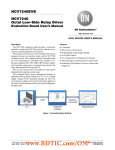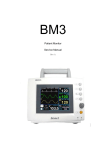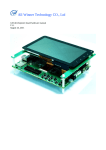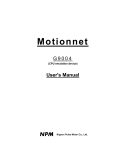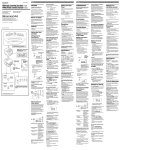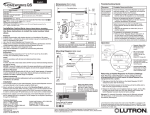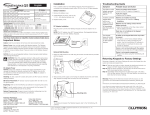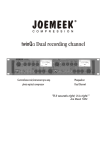Download NCV7240 Octal Low-Side Relay Driver Evaluation
Transcript
NCV7240EVB NCV7240 Octal Low-Side Relay Driver Evaluation Board User's Manual http://onsemi.com EVAL BOARD USER’S MANUAL Description Features The NCV7240 evaluation board provides a convenient method to evaluate the NCV7240 octal low-side driver in a customer defined application environment. The setup involves the use of a PC installed with custom designed software, an interface board, and the NCV7240 evaluation board. The evaluation board is controlled using the ON Semiconductor FlexMOS GUI installed on a personal computer (PC). The USB to SPI interface adapter board provides master-slave communication between the target demonstration board and the PC. The user can control each of the eight low-side outputs independently using this system setup. The evaluation board’s power management includes an adjustable LDO giving the option for a 3.3 V or 5 V digital supply voltage (VCC) selectable through the GUI. An external power supply can be used by removing a jumper on the board. Visual indicators dictate the board configuration through LEDs. • • • • • • • 8 Channels 600 mA Low−Side Drivers Programmable Logic Supply Voltage 16−bit SPI Control Over Load and Over Temperature Protection Selectable Open Load Detection for LED Loads Dedicated GUI Interface for Device Control and Diagnostic Figure 1. Evaluation Board Solution © Semiconductor Components Industries, LLC, 2012 April, 2012 − Rev. 0 1 Publication Order Number: EVBUM2052/D NCV7240EVB Figure 2. Evaluation Board Table 1. ABSOLUTE MAXIMUM RATINGS Value Units Main Supply Voltage to output pins (OUTx) Rating −0.3 to 36 V Digital Supply Voltage (VCC) −0.3 to 5.5 V USB to SPI Interface Adapter Connector Pins −0.5 to 5.5 V Junction Temperature (NCV7240) −40 to 150 °C Ambient Temperature (Evaluation board) −40 to 105 °C Stresses exceeding Maximum Ratings may damage the device. Maximum Ratings are stress ratings only. Functional operation above the Recommended Operating Conditions is not implied. Extended exposure to stresses above the Recommended Operating Conditions may affect device reliability. Table 2. RECOMMENDED OPERATING CONDITIONS Rating Units Value Min Max External Digital Supply Voltage (VCC) 3.0 5.5 V Main Supply Voltage (VBAT) 5.5 28 V − 0.6 A −40 125 °C DC Output Current Junction Temperature http://onsemi.com 2 NCV7240EVB Table 3. PIN FUNCTION DESCRIPTION Connector Pin Number Terminal Name 24 Pin Interface Connector 1 SCL I2C Clock Line, 3.3 V Levels Description 2 SDA I2C Data Line, 3.3 V Levels 3 GND Ground 4 GND Ground 5 IN4 General-Purpose Output 7, used for parallel control of OUT4 and OUT8 6 PO6 General-Purpose Output 6 7 IN3 General-Purpose Output 5, used for parallel control of OUT3 and OUT7 8 V5_EN 9 IN2 General-Purpose Output 3, used for parallel control of OUT2 and OUT6 10 IN1 General-Purpose Output 2, used for parallel control of OUT1 and OUT5 11 EN General-Purpose Output 1, used for EN, Chip Enable 12 LHI General-Purpose Output 0, used for Limp−Home Logic input 13 GND Ground 14 GND Ground 15 PI1 General-Purpose Input 1 16 PI0 General-Purpose Input 0 17 VIO 3.3 V or 5 V for level translators 18 PI2 General-Purpose Input 2 19 SO SPI data from slave to master 20 SI SPI data from master to slave 21 SCLK SPI clock from master to slave 22 CSB SPI slave chip select bar 23 VTRGT 24 VCC_USB General-Purpose Output 4, used for controlling the LDO reference 5 V Supply from slave to J1 5 V USB voltage from the USB to SPI adapter board to the evaluation board (100 mA max) Supply Requirement VBAT Main Supply Voltage. Powers the NCV7240 drivers and the onboard LDO. GND Ground Low_Side Driver Outputs OUT1 Low−Side Output 1 OUT2 Low−Side Output 2 OUT3 Low−Side Output 3 OUT4 Low−Side Output 4 OUT5 Low−Side Output 5 OUT6 Low−Side Output 6 OUT7 Low−Side Output 7 OUT8 Low−Side Output 8 http://onsemi.com 3 NCV7240EVB Table 3. PIN FUNCTION DESCRIPTION Connector Name Test Points & LED Indicator V5_EN Supply Disconnect EN Description When this signal is high the LDO is programmed for 5 V output. Enable signal for the integrated driver. EN LED is illuminated when the part is enabled. TSD Latched thermal information. LHI Limp−Home Logic Input. IN1 Parallel input 1 used for parallel control of OUT1 and OUT5. An LED is illuminated when the pin is high. IN2 Parallel input 2 used for parallel control of OUT2 and OUT6. An LED is illuminated when the pin is high IN3 Parallel input 3 used for parallel control of OUT3 and OUT7. An LED is illuminated when the pin is high. IN4 Parallel input 4 used for parallel control of OUT4 and OUT8. An LED is illuminated when the pin is high. CSB Chip Select Bar signal produced by the master. CSB LED is illuminated when CSB transition to a low state. SCLK Serial clock signal generated by the master. SI Serial input data from the master. SO Serial output data from the slave. VCC Digital Supply voltage. VCC LED is illuminated when the LDO is regulating. GND Chip Ground J28 J28 disconnects the VBAT supply from the board. No power is delivered to the LDOs when the jumper is disconnected. J29 J29 disconnects VDD supply from the LDO to the board. When the jumper is disconnected, the board can be powered from an external supply. J31 J31 disconnects VDDA supply from the LDO to the board. When the jumper is disconnected, the board can be powered from an external supply. http://onsemi.com 4 NCV7240EVB OPERATIONAL GUIDELINES The material necessary to successfully use the evaluation boards is listed below: • PC running the latest Onsemi FlexMOS GUI • USB cable Type A to Type B • USB to SPI Interface Adapter with Ribbon Cable • NCV7240 Evaluation Board • Power Supply • Resistive, LED, Inductive or Motor Load An application example of the NCV7240 driving relays is shown in Figure 3. Figure 3 shows J28, J29 and J31 jumpers inserted. This powers the on-board LDO regulators for VDD and VDDA. Both VDD and VDDA light their respective LED (D10 and D11) when powered. The multiple VBAT connectors on the terminal blocks help the user connect loads in the system by providing a connection which provides capability for two wires per terminal site. When VBAT voltage is applied to the board, the onboard regulator regulates the VDD voltage. By default, VCC is regulated to 3.3 V, but this can be adjusted to 5 V via the GUI. VCC power to the board is provided via VDDA through R20 and is shown active with diode D2. 14V Figure 3. Application Example device from the drop down box. If the device name doesn’t appear in the drop down box, the latest version of the GUI needs to be installed on the PC. A detailed description of the GUI functionality for the NCV7240 is shown in Figure 4. The FlexMOS GUI is used to enable or disable the device and to control the low−side driver outputs. Once the hardware is configured with the desired load and is interfaced with the USB to SPI adapter, the user can launch the FlexMOS software. Once the software is running, the GUI should automatically identify the connected demonstration board and load the appropriate GUI interface for the low-side drivers. If the software doesn’t recognize the connected demonstration board, manually select the http://onsemi.com 5 NCV7240EVB Figure 4. GUI Overview http://onsemi.com 6 NCV7240EVB TYPICAL CHARACTERISTICS Figure 5. Typical Output Clamping Action Typical Operation a multiple of 8 [16 bit minimum]) is reported on the SO pin after CSB goes low until the first rising edge of SCLK. Detection can be performed by clicking on the TER button in the GUI. Since SI is OR’d with the TER fault, it is important to understand that if the LSB bit (B0) is set high on the previous frame, the TER should be ignored. This is because SI holds the value of B0 until the first SCLK rising edge and TER is latched in before the first rising edge of SCLK. Figure 5 above highlights the clamping action (clamped to 38.2 V) of the NCV7240 as the device turns off when driving an inductive load. In this case, a relay has turned off. The slight hump in the decaying waveform is caused from the mechanical relay action of the system. Transmission Error (TER) The NCV7240 device includes a transmission error detection feature whereby a transmission error (bit count not VDDA VBAT VDD 1 C1 0.1uF 1 J3 J6 J9 VBAT J7 19 22 20 23 SO SI SCLK CSB 14 15 16 17 LHI EN OUT1 OUT2 OUT3 OUT4 OUT5 OUT6 OUT7 OUT8 SO SI SCLK CSB IN4 IN3 IN2 IN1 C3 0.1uF Opt C4 0.1uF Opt J10 D1 C11 0.1uF IN GND NC VCC OUT SO LED NL17SH04 5 4 2 1 2 1 2 1 C7 0.1uF Opt C8 0.1uF Opt C9 0.1uF Opt C10 0.1uF Opt TER 620 0Ohm R26 2 Ohm R2 R4 200Ohm C23 0.1uF J32 C22 0.1uF R1 U3 1 2 3 C6 0.1uF Opt 1 TER R3 C5 0.1uF Opt Vcc Vcc 0Ohm 2 1 3 4 5 6 7 8 9 10 1 2 11 12 IN4 IN3 IN2 IN1 NCV7240 1 2 3 4 5 6 7 QA VDD QB QA QB CA CB RA RB DA DB SA VSS SB MC14013B Figure 6. Evaluation Board (DUT) http://onsemi.com 7 Vcc U2 14 13 12 11 10 9 8 2 1 18 21 LHI EN VDDA VDD 2 1 24 13 GND GND GND GND 2 1 C2 0.1uF CSB J5 U1 NCV7240 J8 HOSTPWR J4 2 1 J2 J1 C12 0.1uF NCV7240EVB IN1 IN2 IN3 IN4 EN LHI CSB 20 2 3 4 5 6 7 8 9 11 1 D1 D2 D3 D4 D5 D6 D7 D8 C13 0.1uF U4 MM74HC573/SOEIAJ 19 Q1 18 Q2 17 Q3 16 Q4 15 Q5 14 Q6 13 Q_CSB Q7 12 Q_VCC Q8 LE OC D3 D2 LED Q_CSB LED Q_VCC 10 Vcc Vcc VCC 1 1 1 1 1 1 1 R5 R6 R9 R8 R7 R10 R11 GND J11 J12 J14 J13 J17 J16 J15 0Ohm 0Ohm 0Ohm 0Ohm 0Ohm 0Ohm 0Ohm R14 620 Vcc 1 SI J26 1 D4 SI 1 24 22 20 18 16 14 12 10 8 6 4 2 VCC_USB SS CSB PI2 TER LHI IN1 V5_EN LHI IN1 V3p3_EN PO6 SDA 23 21 19 17 15 13 11 9 7 5 3 1 D7 D6 D5 LED VTRGT J18 J19 J20 J22 J25 LED LED LED D8 LED D9 1 1 1 1 1 LED SCLK SO SO VIO PI1 EN IN2 IN3 IN4 R19 620 J21 J24 J23 R18 620 R17 620 R15 620 1 J27 EN IN2 IN3 IN4 Vcc SCL VDDA R20 0Ohm U5 AT24C01A 1 2 3 SCL 6 7 8 VCC_USB A0 A1 A2 SDA 5 SDA SCL WP VCC C14 0.1uF Figure 7. Evaluation Board (Interface) JUMPER JUMPER C16 1uF Vin INH VOUT VA 1 J29 C17 1uF 3 6 C15 100nF 5 4 GND TAB 1 2 VIN C18 22uF D10 LED R22 14.7k M1 V5_EN V5_EN MGSF1N02LT1 1 J30 U7 NCV4274 1 C20 100nF C21 1uF VIN GND TAB 2 JUMPER VOUT 3 1 J31 C19 22uF 2 4 VBAT 1 J28 D11 Figure 8. Evaluation Board (Power) http://onsemi.com 8 LED 2 VDDA 2 VDD NCV7240EVB Bill of Materials (NCV7240 Evaluation Board) http://onsemi.com 9 NCV7240EVB EVALUATION BOARD LAYOUT Figure 9. Silk Screen & Drill Holes Figure 10. Top Copper Figure 11. Bottom Copper Figure 12. Board Composite http://onsemi.com 10 NCV7240EVB ON Semiconductor and are registered trademarks of Semiconductor Components Industries, LLC (SCILLC). SCILLC reserves the right to make changes without further notice to any products herein. SCILLC makes no warranty, representation or guarantee regarding the suitability of its products for any particular purpose, nor does SCILLC assume any liability arising out of the application or use of any product or circuit, and specifically disclaims any and all liability, including without limitation special, consequential or incidental damages. “Typical” parameters which may be provided in SCILLC data sheets and/or specifications can and do vary in different applications and actual performance may vary over time. All operating parameters, including “Typicals” must be validated for each customer application by customer’s technical experts. SCILLC does not convey any license under its patent rights nor the rights of others. SCILLC products are not designed, intended, or authorized for use as components in systems intended for surgical implant into the body, or other applications intended to support or sustain life, or for any other application in which the failure of the SCILLC product could create a situation where personal injury or death may occur. Should Buyer purchase or use SCILLC products for any such unintended or unauthorized application, Buyer shall indemnify and hold SCILLC and its officers, employees, subsidiaries, affiliates, and distributors harmless against all claims, costs, damages, and expenses, and reasonable attorney fees arising out of, directly or indirectly, any claim of personal injury or death associated with such unintended or unauthorized use, even if such claim alleges that SCILLC was negligent regarding the design or manufacture of the part. SCILLC is an Equal Opportunity/Affirmative Action Employer. This literature is subject to all applicable copyright laws and is not for resale in any manner. PUBLICATION ORDERING INFORMATION LITERATURE FULFILLMENT: Literature Distribution Center for ON Semiconductor P.O. Box 5163, Denver, Colorado 80217 USA Phone: 303−675−2175 or 800−344−3860 Toll Free USA/Canada Fax: 303−675−2176 or 800−344−3867 Toll Free USA/Canada Email: [email protected] N. American Technical Support: 800−282−9855 Toll Free USA/Canada Europe, Middle East and Africa Technical Support: Phone: 421 33 790 2910 Japan Customer Focus Center Phone: 81−3−5817−1050 http://onsemi.com 11 ON Semiconductor Website: www.onsemi.com Order Literature: http://www.onsemi.com/orderlit For additional information, please contact your local Sales Representative EVBUM2052/D











